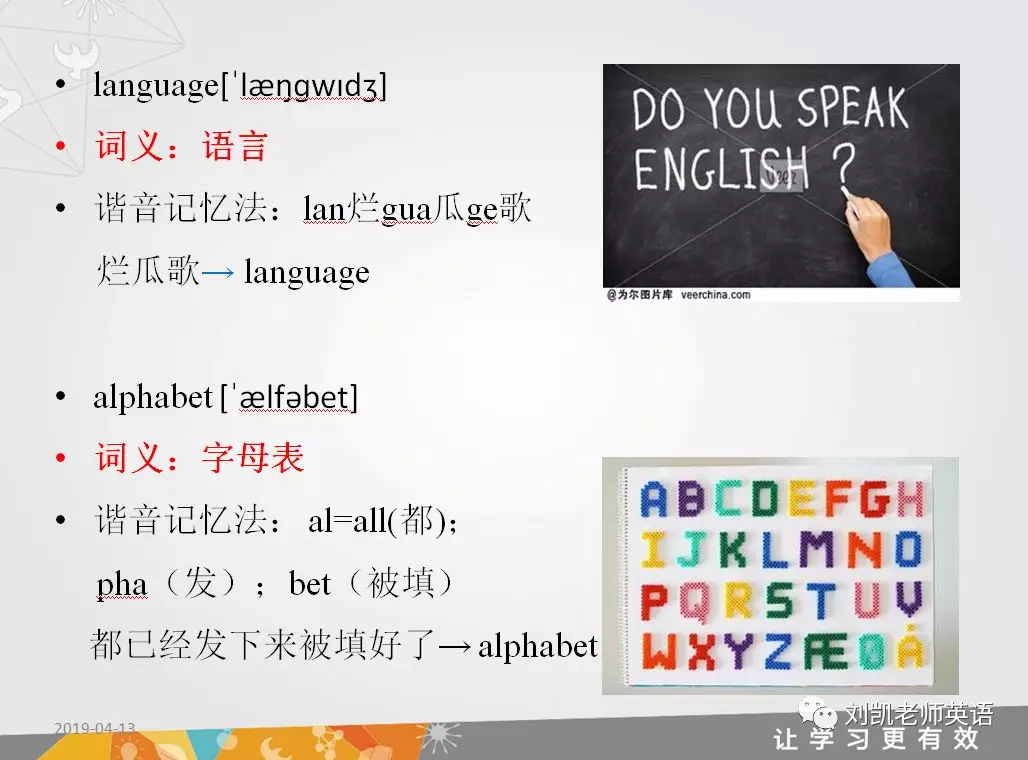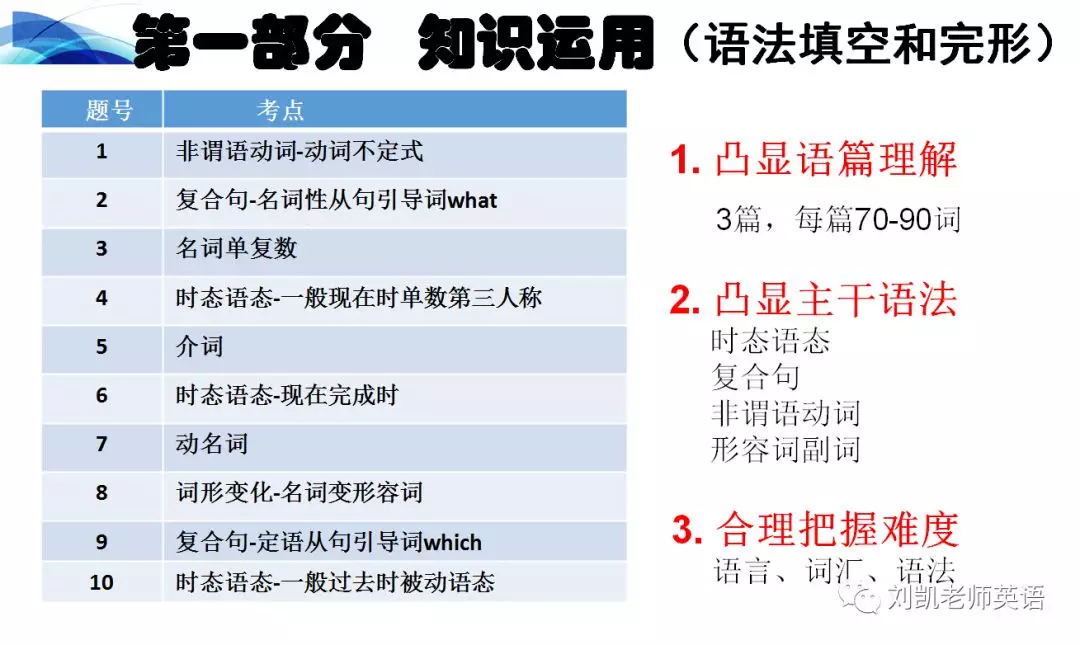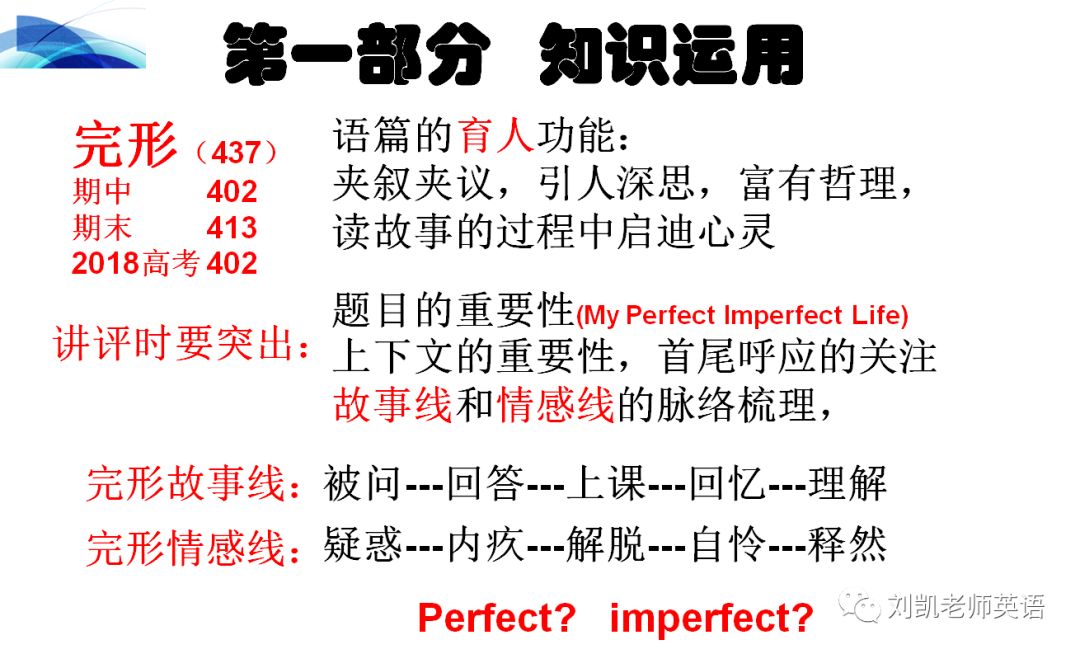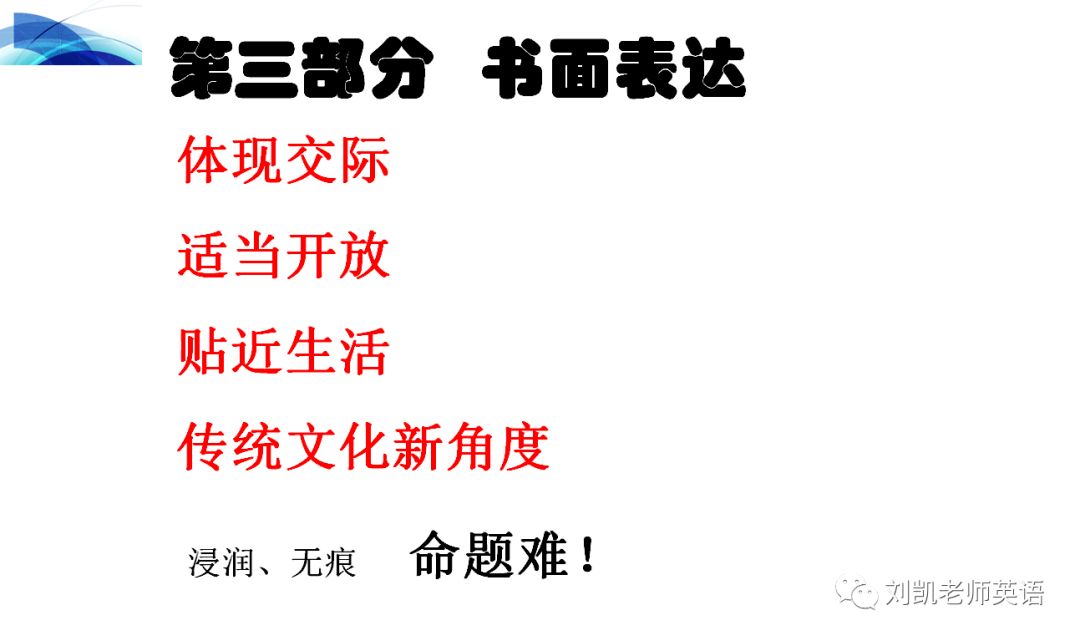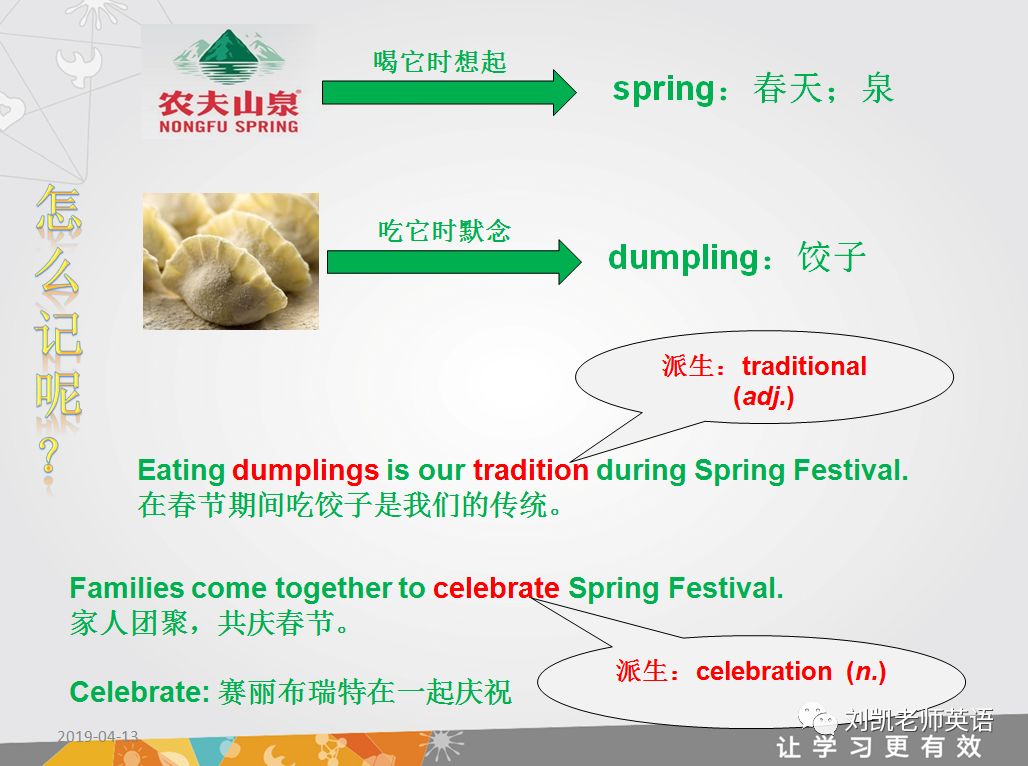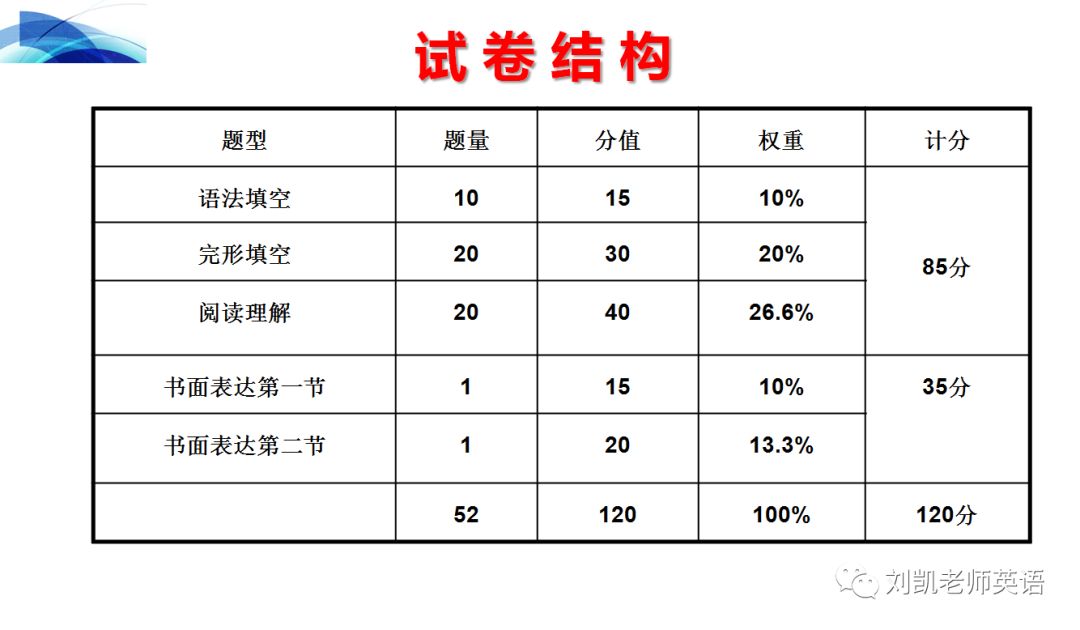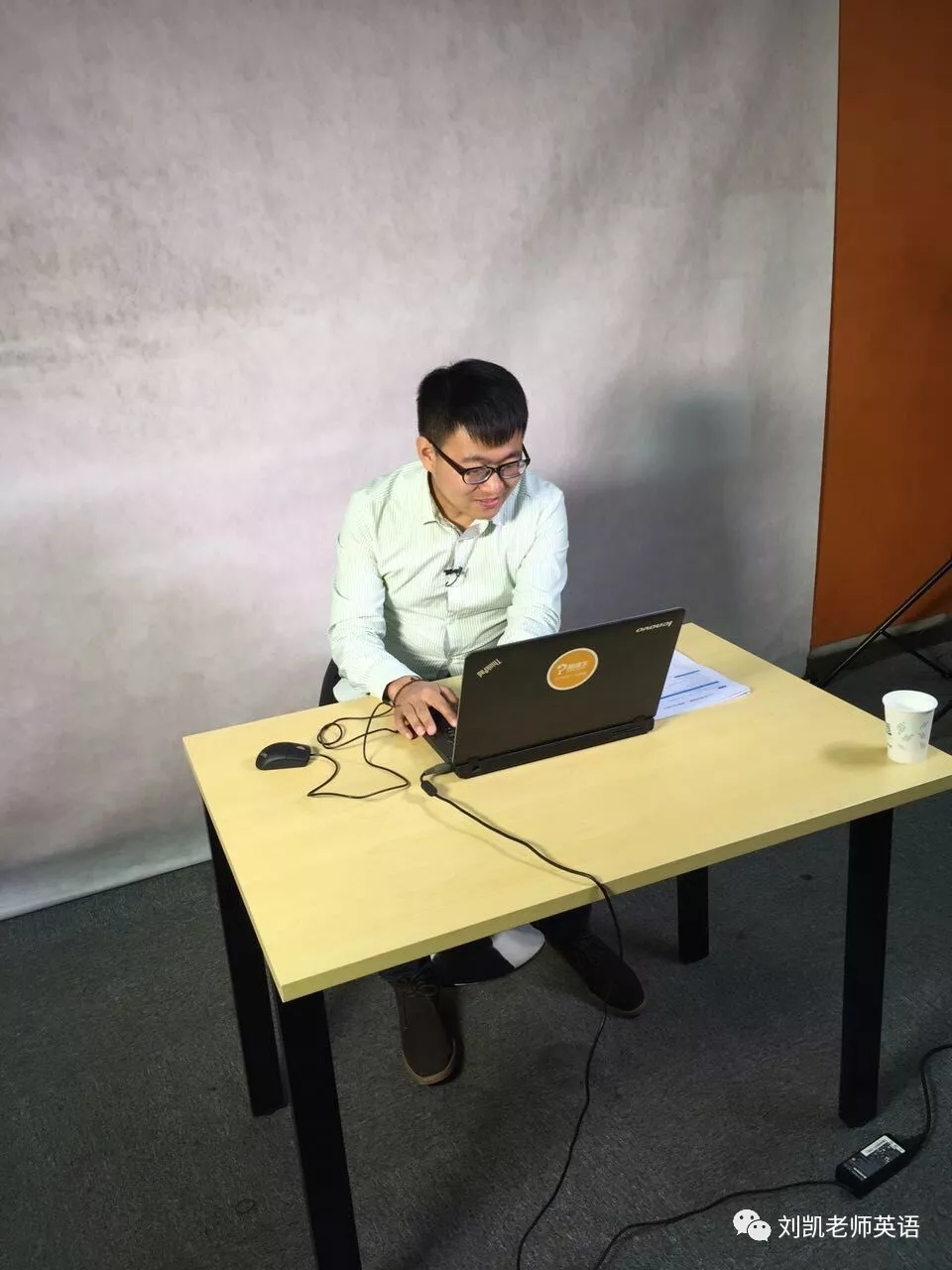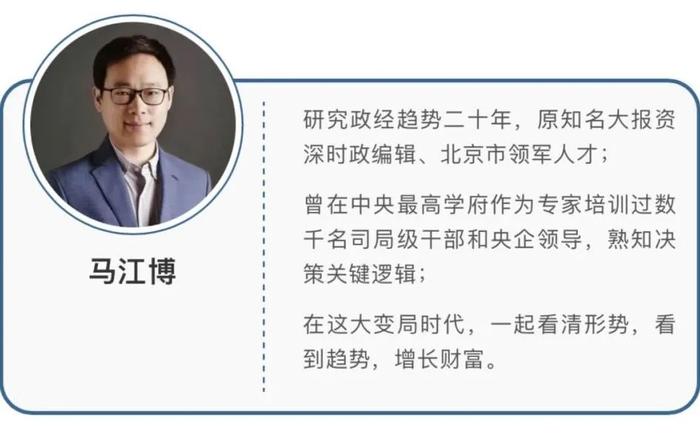2019年北京市西城区高三英语一模试卷评析
1、试卷整体分析
hello,各位同学们大家好:
在大家的期待中:北京市最后一个城区西城的英语一模已经结束了,这次刘凯老师为大家分析西城的试卷,还是想把其他城区,尤其是海淀区结合起来,也希望通过分析能给大家一个高考前复习的一个建议。每年的一模考试,尤其是海淀和西城的一模,是当年高考走向的最重要的一个参考依据。两个城区出题质量都较高,有很明显的区分度。这次海淀一模的难易主要体现在大块上,比如说语法填空和七选五整体都很简单,而完型填空和阅读相对较难。西城区的难易主要体现在每一大块都有难题,也都有简单的题,相对比较均衡。这两个城区的一模对大纲词汇要求都较高,涉及到一些大纲中含义较难词汇以及词汇在特定语境中的深入含义,所以词汇不过关的学生做题中会产生很大的阅读障碍,而影响到做题质量。总体来说海淀和西城区的设题思路和北京高考还是相当接近的,下面对这次西城试卷一模各题型做一下分类具体分析。
1.语法填空
A
I often help my mom cook and bakedchicken is my favorite thing to make. One day, when mom was sick, I tried tomake the chicken all by myself. I washed the chicken and put it in a pan in theoven 1 (bake). When the bell rang to tell me thechicken was done, I opened the oven door. Guess what? The chicken was notcooked! I started to laugh. I forgot to turn 2 the oven! Did you know what I did next? I 3 (order) pizza. Mom was happy I “cooked” bymyself and we could eat the pizza together.
B
Chocolate was first used as a drinkover 3,500 years ago in Central America. It was very popular with the Mayansand the Aztecs. In fact, cocoa beans were very important to people there. Thatwas 4 they were used as money. In the beginning,cocoa 5 (plant) in Ecuador, which was, for a longtime, the world’s number-one producer of cocoa beans. It is still one of thetop 6 (producer) of the beans, but nowadays morethan 70 per cent of cocoa beans come from West Africa.
C
Wallace’s giant bee is the world’s 7 (large) bee, with a body the size of a humanthumb and wings that can spread to about 2.5 inches. That may sound 8 (frighten), but the bee isn’t likely to hurtanyone. It uses its large jaws (嘴) to collect a sticky goo, calledresin, from trees. The bee 9 (make) its home in termitemounds (白蚁丘) found on trees, using the resin to protect its nest from thetermites. Until recently, the bee had been seen by scientists only 10 (two), once in 1868 and again in 1981.
语法填空是今年新出的题型,和前几年考试的语法选择比较来说,语法填空更注重考察语法中最基本最重要的知识点。此次西城一模依然涵盖了大部分重要基础语法知识点,时态语态(3),非谓语动词(2),从句 (1),名词(1),形容词(1),介词(1),词性转换(1)。
2.完形填空
第二节完形填空(共20小题;每小题1.5分,共30分)阅读下面短文,掌握其大意,从每题所给的A、B、C、D四个选项中,选出最佳选项,并在答题卡上将该项涂黑。
We first met Tom and Gee in the earlydays of our marriage. Someone had been 11 our garbage cans to the garage each garbageday, and Jim and I had wondered 12 . Then one day we 13 him: an elderly man who lived across thestreet.
I baked cookies and left them on achair outside the garage 14 a thank-you note. When wegot home from work that day, a typed letter had replaced the 15 . The letter was from Tom and explainedhow he had come to 16 the neighborhood on garbageday, returning cans for people he 17 knew. Back when he’d been fighting a war Iwasn’t alive to see, his young wife, Gee, had found herself living alone.Neighbors had taken the time to 18 her garbage cans so 19 didn’t have to, and he 20 forgot. Now he paid it forward by doing thesame for all of us.
A few years after we’d moved in, Tomdied. We photocopied that letter and 21 it to one of our own for Gee. We told her how 22 Tom had been to us, how sad we felt sorry forher, how thankful we were to have 23 him. She wrote back and told us she stilltalked to Tom every day.
These days, we’re planning a 24 . The house that seemed so huge sixyears ago is filled with furniture and books and toys and, of course, people.We know it’s time to go, and 25 we can’t seem to stickthe For Sale sign up on the lawn. Gaining a third bedroom sometimes seems likean awful trade for all we stand to 26 .
It’s not just Gee. It’s the man wholets our kids pick peaches off the tree in his front yard. It’s the ladies who 27 Jim when their pool filter (过滤器) breaks andleave overflowing baskets for our kids on Easter. It’s the police officerliving directly across from us, who smiles and waves and makes me feel a little 28 when Jim is away.
The moving boxes are still neatlypacked in our basement, but Jim and I agree to 29 until January. Maybe before leaving I’ll talkto Tom, just as Gee still does. Thank you, I’ll say, for teaching us what itmeans to be a 30 .
11. A. lifting B. returning C.delivering D. fixing
12. A. who B.what C. how D.why
13. A. visited B.caught C. spotted D. followed
14. A. in B. for C.to D. with
15. A. gift B.chair C. garbage D.cake
16. A. protect B.search C. walk D. greet
17. A. only B.barely C. nearly D. surely
18. A. handle B.change C. recycle D. open
19. A. they B. we C. he D. she
20. A. never B.always C. sometimes D. seldom
21. A. wrapped B.connected C. attached D. exposed
22. A. special B.hopeful C. powerful D. lucky
23. A. contacted B.remembered C. known D. understood
24. A. party B.trip C. meeting D.move
25. A. also B.yet C. then D. therefore
26. A. win B.lose C. fail D. save
27. A. help B.treat C. charge D.call
28. A. stronger B.happier C. safer D. firmer
29. A. plan B.wait C. prepare D.talk
30. A. husband B.friend C. couple D. neighbor
高考完型填空的选材通常都离不开“励志类”和“真善美”两大经典主题,而西城区一模出题者尤其偏好“真善美”这一主题,今年以“邻居间的互帮互助”做为主题,再一次体现了人与人之间的真情,同时也再次重现了去年北京高考完型“感恩互助”的经典场景。从设题角度看,难度适中,篇章选项中的单词不难,但因这篇完型涉及的人物较杂,阅读篇章时要注意人称代词,并理清篇章中的人物关系,除了事件的线索,还要把握好情感主线。选词时还是要多注意前后的语境关联词以及熟词多义。
3.阅读理解
A
Amsterdam Destination Guide
Amsterdam is one ofthe most popular travel destinations in the world, famous for its beautifulcanals, top art museums, cycling culture and so on. It is the capital and mostpopulous city in the Netherlands and often referred to as the “Venice of theNorth” because of its expansive system of bridges and canals. Here are some ofthe key points to remember as you plan your trip to Amsterdam.
Boom Season
Population
Language(s)
Currency
January Climate
July Climate
May to October
813,562
Dutch
Euro
Average high: 5.8 °C
Average high: 22.0 °C
Must-See Attractions
Most visitors begintheir Amsterdam adventure in the Old Centre, which is full of traditionalarchitecture, shopping centers, and coffee shops. You’ll also want to check outAmsterdam’s Museum Quarter in the South District, which is great for shoppingat the Albert Cuyp Market and having a picnic in the Vondelpark. The topmuseums to visit there are the Rijksmusuem, the Ann Frank House, and the VanGogh Museum.
If You Have Time
There are severalother unique districts in Amsterdam, and you should try to explore as many ofthem as time allows. The Canal Ring is a UNESCO World Heritage Site that wasoriginally built to attract wealthy home owners and is a center for celebrityspotting and nightlife today. The Plantage area has most of the city’s museums,including the Jewish Historical Museum, the Scheepvaart Museum, and thebotanical gardens.
Money Saving Tips
- Unless you really want to see thetulips (郁金香) blooming, avoid booking between mid-March and mid-May. This iswhen hotel and flight prices rise.
- Look for accommodations in Amsterdam’sSouth District, where rates are generally cheaper than in the city center.
- Buy train tickets at the machine insteadof the counter to save a bit of money.
- Instead of hiring a tour guide, hop ona canal boat. They’re inexpensive and will give you a unique point of view ofthe city.
Check out our homepage to viewprice comparisons for flights, hotels, and rental cars before you book.
31. What can be learned about Amsterdam from this passage?
A. Amsterdam is calledthe “Venice of the North” because of its location.
B. The Van Gogh Museumlies in Amsterdam’s Museum Quarter.
C. The Old Centre is aUNESCO World Heritage Site.
D. The Canal Ring is aplace to attract garden lovers.
32. In order to save money in Amsterdam, you can ______.
A. arrange a guidedcanal tour
B. buy train tickets atthe counter
C. reserve a hotel inthe South District
D. book flights betweenmid-March and mid-May
33. Where is the passage most probably taken from?
A. A magazine. B.An essay.
C. A report. D. A website.
B
Three months afterHurricane Katrina in 2005, Rebecca Sell, then 24, a photojournalist for Fredericksburg photographed a NewOrleans couple worriedly examining water-spotted photo albums. As she took thephoto, something within her clicked. “I told them I could take the ruinedpictures, copy them and give them digitally restored (修复) photos,” she recalls. Although a bit sceptical, the coupleagreed. Rebecca took their photos home, restored them and took them to thecouple at their temporary home. “It felt so good to be able to do that forthem,” says Rebecca.
When her editor, Dave Ellis,saw the photo of the couple, he suggested they go back and restore damagedphotos for even more people. So in January 2006, with paid time off from thepaper, the two set up shop in Pass Christian. After posting a notice in thecommunity newsletter, Rebecca and Dave received 500 photos in four days. Foreach, the pair took a new digital picture, then used high-tech software toerase water spots and restore colors. It just so happened that a popularwebsite linked to Dave’s blog about the experience, and soon Operation PhotoRescue, as it came to be known, had emails from hundreds of volunteers,including photographers and restoration experts, eager to help.
Though digitalrestoration is a painstaking process, mending irreplaceable family picturesmeans the world to victims like Emily Lancaster, 71, who took out piles ofruined photo albums after Katrina, never thinking the mess could be saved. Butshe just couldn’t bear to part with a few treasured pictures, including aportrait of her father, who had passed away, and a photo of her husband as aboy. Then she heard about Operation Photo Rescue. “I didn’t have a whole lot ofhope they could fix them, but they did,” Emily says. “Almost every day I thinkabout all the pictures I’ve lost. I’m so happy to have these two.”
In the five yearssince Katrina, Operation Photo Rescue has collected thousands of picturesruined by floods, hurricanes and tornadoes. Volunteers make “copy runs” todisaster areas across the country to gather damaged photos from survivors;operating costs are covered by donations. “It’s great to be able to give peoplesome of their history back,” says Rebecca. “One person told me that thanks tous, her grandmother got to see her photos again before she passed away. Momentslike that remind me why I do this.”
34. When Rebecca took the picture of the New Orleans couple,she decided to ______.
A. take them to their temporary home B. help with their damaged photos
C.set up shop in Pass Christian D. cover Hurricane Katrina
35. From Paragraph 2, we know that Dave and Rebecca ______.
A. quit their jobs in2006 B.inspired volunteers to join them
C. spent four daysmending the photos D. made their workknown in their newspaper
36. How did Emily Lancaster feelwhen she first heard about Operation Photo Rescue?
A.Excited. B. Hopeless. C. Satisfied. D. Sceptical.
37. What is the best title for the passage?
A.Surviving Hurricanes B. An Act ofGenerosity
C. Saving Memories D. A Lucky Couple
C
Like many other people who speak morethan one language, I often have the sense that I’m a slightly different personin each of my languages—more confident in English, more relaxed in French, moreemotional in Czech. Is it possible that, along with these differences, my moralcompass (指南针) also points in somewhat different directions depending on thelanguage I’m using at the time?
Psychologists who study moral judgmentshave become very interested inthisquestion. The findings of several recent studies suggest that when peopleare faced with moral dilemmas (困境), they do indeed respond differentlywhen considering them in a foreign language than when using their nativetongue.
In a 2014 paper led by Albert Costa,volunteers were presented with a moral dilemma known as the “trolley problem”:imagine that a runaway trolley is moving quickly toward a group of five peoplestanding on the tracks, unable to move. You are next to a switch that can movethe trolley to a different set of tracks, therefore sparing the five people,but resulting in the death of one who is standing on the side tracks. Do youpull the switch?
Most people agree that they would. Butwhat if the only way to stop the trolley is by pushing a large stranger off afootbridge into its path? People tend to be very hesitant to say they would dothis, even though in both situations, one person is sacrificed to save five.But Costa and his colleagues found that presenting the dilemma in a languagethat volunteers had learned as a foreign tongue dramatically increased theirstated willingness to push the sacrificial person off the footbridge, fromfewer than 20% of respondents working in their native language to about 50% ofthose using the foreign one.
Why does it matter whether we judgemorality in our native language or a foreign one? According to one explanation,such judgments involve two separate and competing ways of thinking—one ofthese, a quick, natural “feeling,” and the other, careful deliberationabout the greatest good for the greatest number. When we use a foreign language,we unconsciously sink into the more careful way simply because the effort ofoperating in our non-native language signals our cognitive (认知的) system toprepare for difficult activity.
An alternative explanation is thatdifferences arise between native and foreign tongues because our childhoodlanguages are filled with greater emotions than are those learned in moreacademic settings. As a result, moral judgments made in a foreign language areless filled with the emotional reactions that surface when we use a languagelearned in childhood.
There’s strong evidence that memoryconnects a language with the experiences and interactions through which thatlanguage was learned. For example, people who are bilingual (双语的) are morelikely to recall an experience if reminded in the language in which that eventoccurred. Our childhood languages, learned in the middle of passionate emotion,become filled with deep feeling. By comparison, languages acquired late inlife, especially if they are learned through limited interactions in theclassroom or dully delivered over computer screens and headphones, enter ourminds lacking the emotionality that is present for their native speakers.
- 38. What does “this question” inParagraph 2 refer to?
- A. What contributes to one’s languageimprovements?
- B. Is it necessary to learn more thanone foreign language?
- C. Does the language one uses influenceone’s moral judgments?
- D. How do people deal with moraldilemmas in a foreign language?
- 39. When the “trolley problem” was presented in a foreignlanguage, volunteers were more likely to ______.
- A. care lessabout the five people
- B. pull theswitch to the side tracks
- C. remainhesitant about what to do
- D. sacrificethe stranger on the footbridge
- 40. The underlined word in Paragraph 5is closest in meaning to ______.
- A. consideration B. guidance C. selection D. arrangement
- 41. What can we learn from the last twoparagraphs?
- A. Bilingual people are less emotionalthan others.
- B. Native language learning involvesgreater emotions.
- C. Childhood memories limit foreignlanguage learning.
- D. Academic settings promote foreignlanguage learning.
D
We talk continuously about how to makechildren more “resilient (有恢复力的)”, but whatever we’re doing, it’s notworking. Rates of anxiety disorders and depression are rising rapidly among teenagers. What are we doing wrong?
Nassim Taleb invented the word“antifragile” and used it to describe a small but very important class ofsystems that gain from shocks, challenges, and disorder. The immune (免疫的) system isone of them: it requires exposure to certain kinds of bacteria andpotential allergens (过敏原) in childhood in order to develop toits full ability.
Children’s social and emotionalabilities are as antifragile as their immune systems. If we overprotect kidsand keep them “safe” from unpleasant social situations and negative emotions,we deprive (剥夺)them of the challenges and opportunities for skill-building they need to growstrong. Such children are likely to suffer more when exposed later to otherunpleasant but ordinary life events, such as teasing and social rejection.
It’s not the kids’ fault. In the UK, asin the US, parents became much more fearful in the 1980s and 1990s as cable TVand later the Internet exposed everyone, more and more, to those rareoccurrences of crimes and accidents that now occur less and less. Outdoor play and independent mobility went down; screen time and adult-monitored activitieswent up.
Yet free play in which kids work outtheir own rules of engagement, take small risks, and learn to master smalldangers turns out to bevital for the development of adultsocial and even physical competence. Depriving them of free play prevents theirsocial-emotional growth. Norwegian play researchers Ellen Sandseter and LeifKennair warned: “We may observe an increased anxiety or mental disorders insociety if children are forbidden from participating in age adequate riskyplay.”
They wrote those words in 2011. Overthe following few years, their prediction came true. Kids born after 1994 aresuffering from much higher rates of anxiety disorders and depression than didthe previous generation. Besides, there is also a rise in the rate at whichteenage girls are admitted to hospital for deliberately harming themselves.
What can we do to change these trends?How can we raise kids strong enough to handle the ordinary and extraordinarychallenges of life? We can’t guarantee that giving primary school children moreindependence today will bring down the rate of teenage suicide tomorrow. Thelinks between childhood overprotection and teenage mental illness aresuggestive but not clear-cut. Yet there are good reasons to suspect that bydepriving our naturally antifragile kids of the wide range of experiences theyneed to become strong, we are systematically preventing their growth. We shouldlet go—and let them grow.
42. Why does the author mention the immunesystem in Paragraph 2?
A.To stress its importance. B.To analyze the cause of anxiety.
C.To question the latest discovery. D.To help understand a new word.
43. Parents overprotect children because______.
A.they are concerned about their children’s safety
B.they want to keep children from being teased
C.parent-monitored activities are a must
D.children are not independent enough
44. According to the author, free play can______.
A.promote children’s resilience
B.strengthen children’s friendship
C.reduce children’s risky behavior
D.develop children’s leadership skills
45. Which of the following does the authorprobably agree with?
A.Stop trying to perfect your child.
B.It takes great courage to raise children.
C.Prepare the child for the road, not the road for the child.
D. Whilewe try to teach our children all about life, our children teach us what life isall about.
此次阅读理解总体偏难。篇章阅读上,主要体现在“两长一难”,两长是指篇章较长,句子较长;难是指单词较难。在题型方面,推理判断题和复杂细节题所占比重加大,这类题出处点定位较麻烦,需要耐心定位,另外对出处点细节理解要求较高,迷惑性选项比较大。另外今年西城和海淀的C篇都比D篇难,要多注意,今年高考阅读的难点有可能由传统D篇转向C篇倾斜。C篇相对于D篇设题迷惑性选项更多,更注重细节理解,之后的两个月在这方面能力要加强训练。
4.七选五
第二节(共5小题;每小题2分,共10分)根据短文内容,从短文后的七个选项中选出能填入空白处的最佳选项。选项中有两项为多余选项。
Today’sstudents are surrounded by information. The ability to figure out exactly whyauthors write—and not accept every opinion as fact—is a key skill. 46 The following strategies teach them how tofigure out why authors really write.
Start with why. “Why did theauthor write this piece?” is the key question asked to identify author’spurpose. To help students expand their understanding of “why,” post various typesof nonfiction (an advertisement, opinion article, news article, etc.) aroundyour classroom and have students quickly identify a purpose for each. 47
Talkabout structure. Authors use different structures for different purposes. Forexample, one author may use time order to explain an event, while anotherauthor uses compare and contrast to put that event into context.
48 Often when authors write, they’re trying to get readers to feela certain way. Perhaps the author of an article about whale conservation wantsreaders to feel sad about the difficult situation of whales. Or the author of aletter may want to make the recipient feel better about a situation. Afterstudents read a text, stop and ask: How do you feel? And how did the author getyou to feel this way?
Connect it to students’ own writing. It doesn’t have to be said thatwriting and reading go hand in hand. 49 When students are asked to write about a topicthat they think everyone should know about, to explain a procedure or to sharea personal memory, they’ll become more conscious of how authors approachwriting.
Observehow purpose changes within a text. Author’s purpose is often studied throughthe text as a whole, but authors have different reasons for writing within textsas well. 50 Then, they may launch into a list of factsthat make the reader feel discouraged about the situation. And finally, theymay conclude with an appeal. Take a short article and break it apart,identifying the different purposes so that students see how author’s purposechanges as they read.
A. Get to the heart.
B. Identify the topic.
C. The readers may get more advanced intheir work with informational text.
D. For example, an author may include afunny anecdote (轶事)to draw the reader in.
E. In particular, they'll need tofigure out author’s purpose and draw their own conclusions.
F. Expand students' awareness of whypeople write by having them write for different purposes.
G. Or keep a running Author's Purposeboard with a list of the various reasons that authors write.
西城的七选五篇章选材选取了比较“抽象“的方法建议类文章,并且和海淀区一样,篇章的结构都模仿了去年北京高考题七选五的”总分分分“的结构,这样的结构因为段落鲜明按理来说应该好选一些,但与比较简单的海淀区比起来,西城区还是要难一些,主要体现在抽象表达的句意理解上,但要是注意句子前后的特定关键词以及结合一些代词的技巧,选起来也不是特别难。
5.作文
应用文
第三部分:书面表达 (共两节,35分)
第一节(15分)你的英国朋友Jim对你们学校的学生社会实践活动非常感兴趣。他来信希望你介绍这方面的有关情况。请你给他回信,内容包括:
1. 学校有哪些社会实践活动;2. 你最喜欢哪一类活动;3. 喜欢的原因。
注意:1. 词数不少于50;2. 开头和结尾已给出,不计入总词数。提示词:社会实践活动 extracurricular activity
Dear Jim,
这次的应用文依然是经典的介绍类作文,介绍学校有哪些社会实践活动,最喜欢哪一类,以及喜欢的理由。大部分的学生高中都经历过一些实践活动,应该对此题材比较熟悉,写起来难度不大。一模后应用文还是要在内容的准确性、逻辑性以及交际功能性方面重点加强,另外要把最常考的介绍传统文化的素材多背并记熟。
情景作文
第二节:(20分)假设你是红星中学高三年级学生李华. 请根据以下四幅图的先后顺序,写一篇英文周记,记录上周你制作以“我眼中的改革开放40年”为主题的小报的全过程。
注意:词数不少于60。
提示词:改革开放四十年40years of China’s reform and opening-up
改革开放四十周年展览exhibitioncommemorating the 40th anniversary of China’s reform and opening-up
西城一模的情景作文对“动手制作能力”和“家人”两者组合一向是情有独钟,从15年一模的“和奶奶学剪纸”,到16年一模的“给爷爷制作相册生日礼物”,再到17年“帮妈妈制做书架”。果不其然,今天的西城一模,又一次考了在爸爸妈妈的协助下制作了改革开放四十周年小报。这次作文要是平常多积累一些涉及制作类场景相关的常见词汇词组以及一些套用句式,写起来不是很难。要说西城一模以“动手”著称,他的邻居东城一模情景作文则以“动脑“和”校园同学“组合的各种竞赛名声在外,从15年一模的”板报比赛’到16年一模的‘诗词比赛“,再到17年一模的”丝绸之路竞赛“。区域面积较小的东西城只能在家里或学校活动,而地域最广的朝阳区则”动腿“选择了走出”户外”,一模作文常以“公益活动”和”陌生人“为主题,亲近大自然的同时又助人为乐,充当志愿者,从而也就产生了各种各样去公园帮助人,去做公益事件的朝阳一模惯有的题材。当然以文化教育著称的“海淀区”更不甘示弱,近几年一模拿起了传家宝“传统文化”奔波于家里、学校、餐馆和公园,并和外国人一起,把文化传播到更远的国外。
横向看这四个城区的一模,再纵向看北京近四年真题,我们毫无疑问的发现,北京的考题逃脱不了经典的四大主题:制作展示类、校园活动类、参观访问类(传统文化)和公益事件类。而且经常这四种的其中两个会组合到一起。海淀区15年、18年真题中出现了参观访问,而西城区的制作展示场景在15、16、17、18真题中全部都出现过,也难怪今年的西城区这次一模试题中依然打出了这张王牌。
结合上面分析的情景作文的走向及特点,建议大家在考前要多归类整理四类型的常见的相关高频场景以及用词和句型套路,并结合典型一二模题多做灵活训练,情景作文还是很容易得到理想分数的。
2、考点分析
题目序号
考点
难度(五星评定)
1
语法填空
★★★
2
完形填空
★★★
3
阅读理解
★★★★
4
七选五
★★★★
5
应用文
★★★
6
情景作文
★★★★
3、一模后高考前学习建议
1.注重基础、针对练习。
词汇、语法是英语重要的基础。越到考前,越不能忽视。3050大纲中的单词要重复记忆巩固,完型高频词以及一些常见的熟词多义要重点记忆。语法方面,语法填空中要考的基础语法不要有任何疏漏,对于基础破弱的学生,不规则变化动词以及常见的词性转换的词一定要记牢。另外对于高级语法中的三大从句、非谓语动词以及倒装强调句要能运用到阅读长难句分析中,并活用到作文中。
2.突出重点,强化考点。
要多做一些近几年重点城区的北京一二题来强化阅读理解的重点题型,增强应试技巧,另外作文中的常考的类型(参观访问、公益事件、校园活动、制作展示)要重点练习,同时加强常见场景以及词类句式套路的灵活运用。
3.题型梳理,知识整合。
最后阶段要对知识点要进行归纳整理,并且对所有以前做错的错题进行梳理,查漏补缺,突破还未熟练的考点中的难点。
刘凯老师介绍:
刘凯,男,蒙古族,黑龙江省齐齐哈尔人。本科为哈尔滨师范大学英语系,硕士为华中师范大学汉语言文学。
北京市优秀青年教师,北京市级重点高中示范校骨干教师,多年高中一线执教经验,高三年级把关教师,多次参与东城区模拟试题命题工作,教学理念先进,教学成果突出,多篇教学论文获市区级奖项。教育部课题研究员,参与国家十二五课题计划,并作出突出贡献,参与初中、高中各年级区级试题的命制,多次承担区级和市级研究课任务。东城区及北京市科技英语优秀指导教师,所带学生在各级英语口语、作文竞赛中多次获奖;刘凯老师将扎实的英语基本功和严谨的学术思想作为教学的基础,课堂上善于寓教于乐,信息量大,内容丰富,使学生在和谐的课堂气氛下欣赏英语、享受英语、掌握英语、运用英语。
曾多次参加高考阅卷工作,参与人民教育出版社、北京教育出版社、外研社等各类高考教学用书的编写工作,有丰富的备考经验。
2009-2012年期间,多次受邀在北京广播电台主持英语高考大纲解析及英语新课程改革节目,兼具偶像派与实力派特点,教风亲切洒脱,诙谐幽默,思维开阔,屡有奇思妙想,善于引导学生学以致用,对高考动向把握极其准确,深受学生和家长欢迎。
美国亚利桑那大学访问学者,澳大利亚新兰威尔士大学ESL研修。尤其擅长英语语法和单词记忆法。
2018年加州理工学院语言学双学位获得者。讲授科目有长难句、翻译、四六级考试、写作。在2014、2015、2016、2017四年考研中,接受其培训的所有考生中有近万名考生取得高分。
资深考研培训讲师;
英语四六级考试天团高级讲师;
雅思阅读、雅思写作培训主讲名师;
六级考试阅卷组成员;
深谙命题规律和解题套路,对英语的学习规律和方法见解独特。
带给学生的不只是考分的提高,更多的是对英语领悟和感知的突破。纯正的英音、独到的见解、睿智的思维和轻松幽默的语言,为其赢得了广大学生的认同和喜爱。
高考志愿规划师
生涯规划师
国家素质拓展师
高考政策专家

